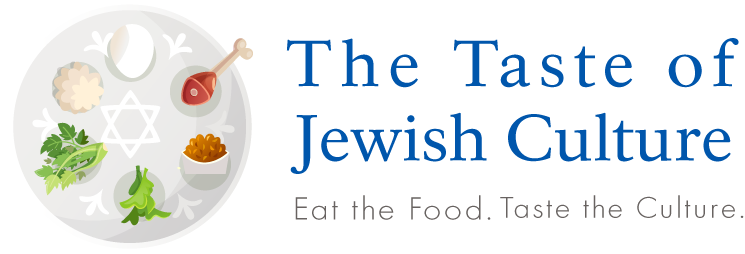Most people don’t eat etrog (citron) these days. There is not a lot of edible pulp inside, and while the rind is sometimes pickled or preserved in other ways, it remains fairly uncommon as a food item. Historically, however, we uncover an interesting culinary connection between Jews and the etrog, but not for its own use and not for reasons connected with its edible properties. Rather, it is due to its religious significance, which led us to become involved in the production of some other, more popular food items.
What is an Etrog?
For starters, what is an etrog, anyway? Resembling a bumpy and oddly-shaped lemon, the citron (as it is called in English) is an ancient fruit. Most citrus fruits eaten today stem from very few original species. Along with pomelos and mandarins, citrons are considered one of the “mother” citrus fruits in the world. Due to the fact that etrogim (the Hebrew plural for etrog) typically self polinate (i.e. from flowers on the same tree), their genetic makeup remains fairly stable, in contrast to most other citrus fruits that developed via successive cross breedings and other modifications. While pomelos and mandarins appear to have originated in China, citrons are believed to be indigenous to India (though there have been other theories previously, including the Arabian peninsula).
Most relevant for this post, however, is the fact that the etrog serves a specific religious purpose for Jews. On the holiday of Sukkot, beginning today, Jews take four botanical products, hold them together, and shake them, ritually during prayers. The etrog is one of the four, along with a palm frond, and branches of myrtle and willow. This practice is based on a passage in the Torah that commands us to take these four items together during this holiday.
Sort of. As I’ll come back to later, the Torah does not command us to take an etrog, and in fact the word appears nowhere in the Jewish Bible. Instead it uses the phrase pri etz hadar — “the fruit of a beautiful tree,” or potentially “the beautiful fruit of a tree.” Certainly today, and even in ancient times, the citron was identified as being the fruit intended by this sentence, though scholars have raised some questions about the possibility of this being accurate. But as I said, more on that later.
So What is the Culinary Connection?

What this meant is that Jews would always have an annual need for citrons — not to eat, but for ritual purposes. While citron trees are somewhat delicate, and can’t just grow anywhere, they do grow well in Israel, the anceint homeland of the Jews. But what about with our continued dispersal around the world, throughout the Diaspora? Wherever Jews moved, they had to figure out where they could source their etrogim from. This great demand meant that cultivating them could be a profitable endeavor.
We know that citrons were the earliest fruit to be cultivated in Europe, typically around the climatically similar Mediterranean region. In the 1950s, however, scholar Erich Isaac wrote a fascinating paper in which he revealed his findings about citron domestication. He noticed tremendous overlap between areas of ancient Jewish population around the Mediterranean basin (along with known depictions of etrogim in Jewish art) and regions that today produce citrus fruit.
While citrus fruits were formerly thought to have been introduced to Europe in the 10th century by Arab conquerers, it appears that they were actually reintroducing them. Following the fall of the Roman Empire, and Europes subsequent slip into the Dark Ages, there was no need or demand for expensive products such as citrus. So whatever production existed, died out. Except for the citron, because the Jews still had their annual need for etrogim.
Additionally, much citrus cultivation worldwide is done by grafting other tree types onto an existing citron base. So Isaac believed it to be very plausible that with Jewish knowledge of citron production, they may have also been among the first to cultivate other citrus fruits in Europe. If you focus on growing a product that is only needed for one week a year (and isn’t even heavily consumed), why not add on the parallel production of the technically similar orange or lemon? And certainly once their reintroduction to Europe, Jews who had the requisite agricutltural knowledge and available grafting stock would have been uniquely positioned to cultivate them as well.
I discuss this topic in my Food Talk “The Original Culinary Movers and Shakers,” all about the role of Jews as transporters of food around the world throughout history.
What About the Etrog’s History (and Culinary Use)?
So why did I say that scholars have debated whether the citron is the fruit described by the Biblical passage about Sukkot? Mainly because it seems that the etrog had not yet arrived in the region when the passage was written, suggesting it couldn’t possibly be the intended fruit. And even for a true believer who might say, “Since God wrote the Torah and knew all species, he most certainly could have intended the etrog,” could we plausibly think that God would have commanded the Israelites to annually utilize a fruit that they didn’t even know existed?
The question, however, is at what point did it reach the region? Can we be certain that it didn’t exist there in Biblical times? Obviously, no, we can’t say it with certainty, since lack of proof does not equal proof of lack. But plausibly, it does not seem likely that it was known in Israel with no references to it in writing, depicted in art, or found in archaeological settings. By contrast, we do know from historical sources, that it existed — and was already widely used — by the second century BCE. A great source for this is Josephus (written first century CE but describing an event from earlier, based on prior historical sources). In 2012, however, an archaeological dig in Jerusalem revealed pollen of the etrog tree among the remains of a royal garden that dated as far back as the fourth or fifth century BCE. While this pushes its presence back significantly further than previously known, it still does not go back far enough for it to believably be what the Torah intended. Plus the context in which it was found suggests it to have been a very special and expensive item at that point, rather than something available to the public.
So were Jews wrong to use the etrog for this ritual? I’m no rabbi, but I’d like to think that since two of the four species are described by name in the sentence (palm and willow), and the other two are simply described (“fruit of a beautiful tree” and “branches of a plaited tree”), maybe the intention was not to specific species at all. If they were intended, why not name them? Perhaps the idea is to give some leeway. And only after the etrog grew popular in Israel, and became recognized as exceedingly beautiful, did it become mandated as the appropriate fruit rather than simply as one of many possibilities. For our purposes, it matters little, since once it became accepted as the mandatory species, it led to the Jewish cultivation that I discussed above.
And what of the culinary aspects of the etrog? Though citrons are certainly still eaten in some forms today, most will tell you not to use your ritual etrog to make food items. In order to keep the fruit as beautiful as possible, and free from blemish, most ritual etrogim today are coated in spray-on pesticides, making the fruits highly unhealthful. But if you get your hands on other citrons and are interested in learning more about what can be done with it (and some of the other historical elements related to the etrog), I encourage you to check out this issue of my friend Harry’s Substack newsletter.
Wishing you all a Happy Sukkot!
Share This With Anyone You’d Think Might Be Interested!







Paulette Jacka
Looking for a way to get millions to engage with your content on a budget? For Details: http://f65854.contactblastingworks.my
jonathan jonathan
Hello,
I have a proposition for you tied to your last name . If interested kindly indicate in your response, so I can provide you with further information. Kind regards,
John Marsha
Virginia Hamlin
Hi,
Just wanted to say that I love your content. Keep up the good work.
My friend Jordan from Thailand Nomads recommended your website to me.
Cheers,
Virginia Hamlin